Typical values at TA = +25°C with
nominal supplies. Unless otherwise noted, TX input data rate = 491.52MSPS,
fDAC = 11796.48MSPS, interleave mode, AOUT = –1
dBFS, 1st Nyquist zone output, Internal PLL, fREF =
491.52MSPS, 24x Interpolation, DSA = 0 dB, Sin(x)/x enabled, DSA calibrated.
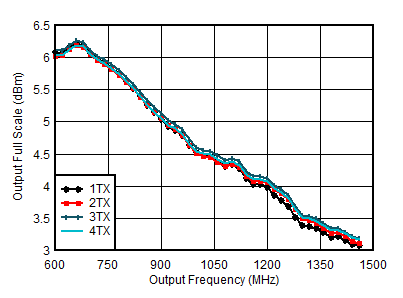
| Including PCB and cable losses, Aout = -0.5dFBS, DSA = 0, 0.8 GHz matching |
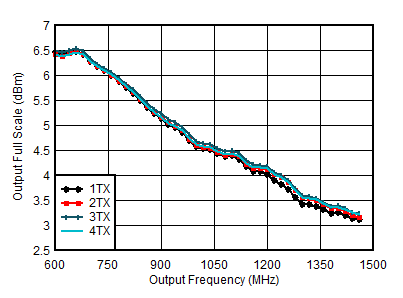
| Including PCB and cable losses, Aout = -0.5dFBS, DSA = 0, 0.8 GHz matching |
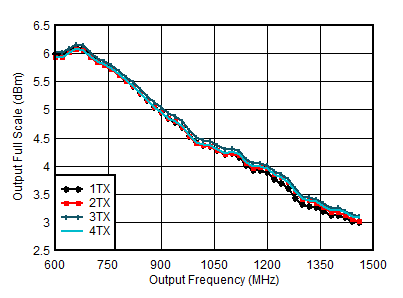
| Including PCB and cable losses, Aout = -0.5dFBS, DSA = 0, 0.8 GHz matching |
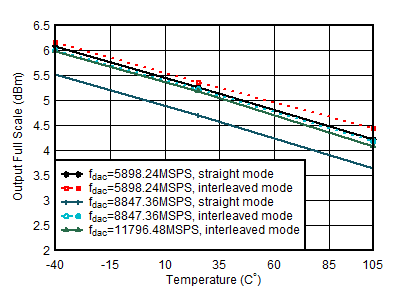
| including PCB and cable losses, Aout = -0.5dFBS, DSA = 0, 0.8 GHz matching |
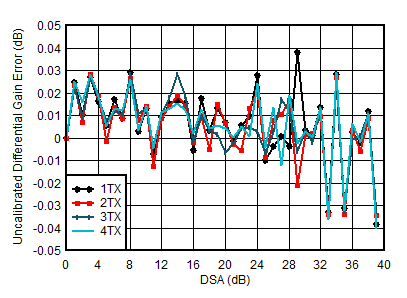
| fDAC=5898.24MSPS, interleave mode, matching at 0.8 GHz |
| Differential Gain Error = POUT(DSA Setting – 1) – POUT(DSA Setting) + 1 |
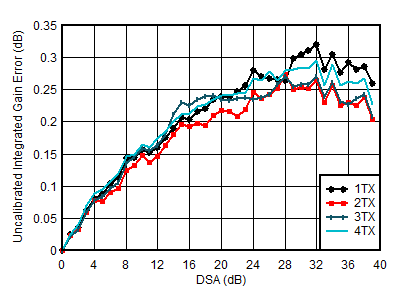
| fDAC=5898.24MSPS, interleave mode, matching at 0.8 GHz |
| Integrated Gain Error = POUT(DSA Setting ) – POUT(DSA Setting = 0) + DSA Settings |
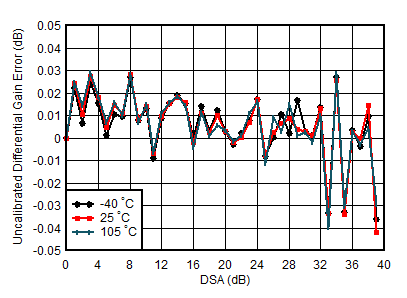
| fDAC = 5898.24MSPS, interleave mode, matching at 0.8 GHz |
| Differential Gain Error = POUT(DSA Setting – 1) – POUT(DSA Setting) + 1 |
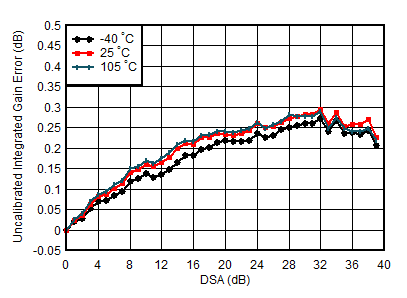
| fDAC = 5898.24MSPS, interleave mode, matching at 0.8 GHz |
| Integrated Gain Error = POUT(DSA Setting ) – POUT(DSA Setting = 0) + DSA Setting |
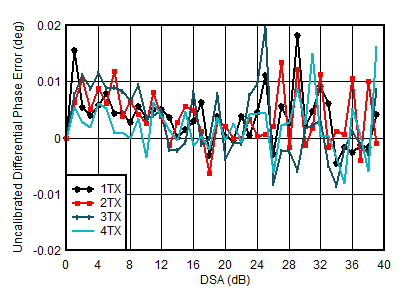
| fDAC = 5898.24MSPS, interleave mode, matching at 0.8 GHz |
| Differential Phase Error = PhaseOUT(DSA Setting – 1) – PhaseOUT(DSA Setting) |
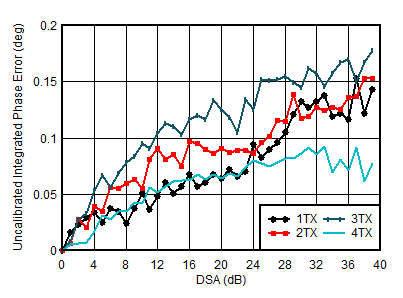
| fDAC = 5898.24MSPS, interleave mode, matching at 0.8 GHz |
| Integrated Phase Error = PhaseOUT(DSA Setting) – PhaseOUT(DSA Setting = 0) |
|
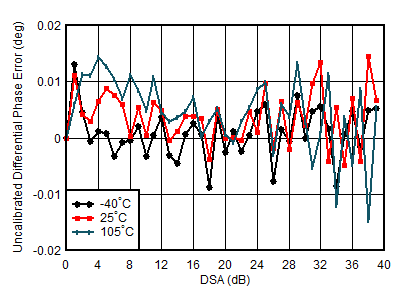
| fDAC = 5898.24MSPS, interleave mode, matching at 0.8 GHz |
| Differential Phase Error = PhaseOUT(DSA Setting – 1) – PhaseOUT(DSA Setting) + 1 |
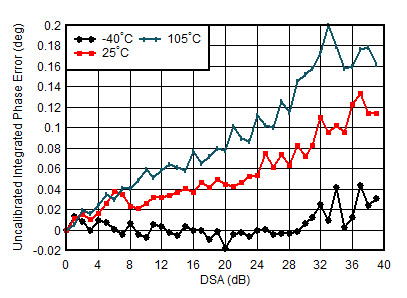
| fDAC = 5898.24MSPS, interleave mode, matching at 0.8 GHz |
| Integrated Phase Error = PhaseOUT(DSA Setting) – PhaseOUT(DSA Setting = 0) |
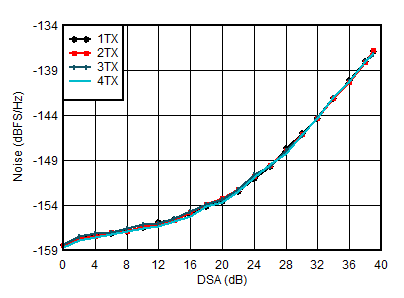
| fDAC = 5898.24MSPS, interleave mode, matching at 0.8 GHz, POUT = –13 dBFS |
|
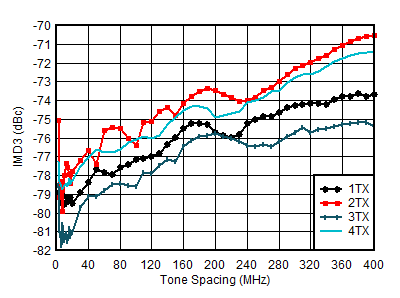
| fDAC = 5898.24MSPS, straight mode, fCENTER = 0.85 GHz, matching at 0.8 GHz, –13 dBFS each tone |
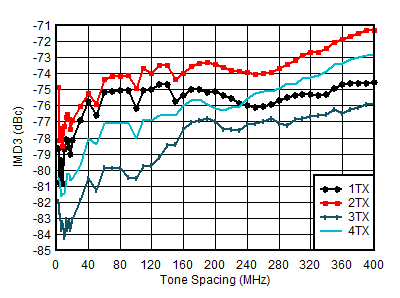
| fDAC = 11796.48MSPS, interleave mode, fCENTER = 0.85 GHz, matching at 0.8 GHz, –13 dBFS each tone |
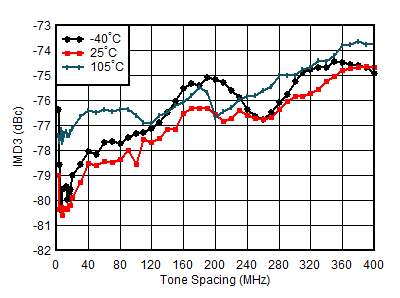
| fDAC = 8847.36MSPS, straight mode, fCENTER =0.85 GHz, matching at 0.8 GHz, –13 dBFS each tone, worst channel |
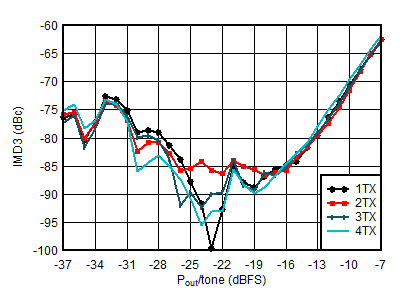
| fDAC = 5898.24MSPS, straight mode, fCENTER = 0.85 GHz, fSPACING = 20 MHz, matching at 0.8 GHz |
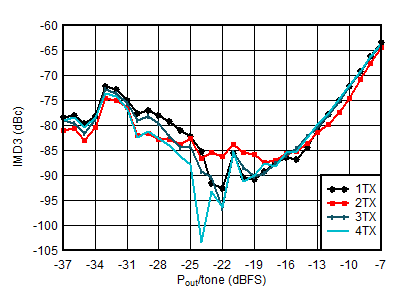
| fDAC = 11796.48MSPS, interleave mode, fCENTER = 0.85 GHz, fSPACING = 20 MHz, matching at 0.8 GHz |
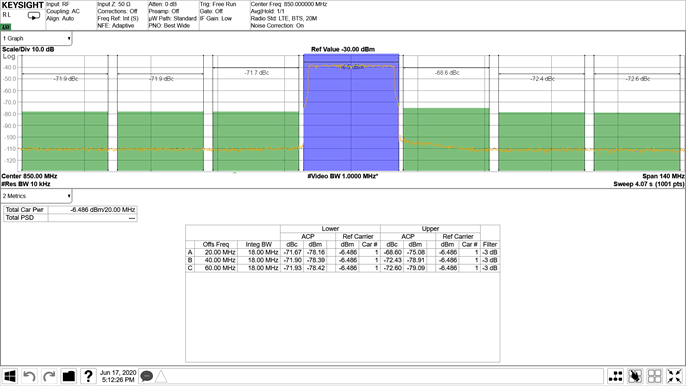
| TM1.1,
POUT_RMS = –13 dBFS |
|
Figure 5-308 TX
20-MHz LTE Output Spectrum at 0.85 GHz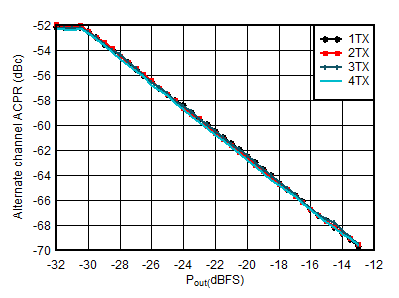
| Matching at 0.8 GHz, single carrier 20-MHz BW TM1.1 LTE |
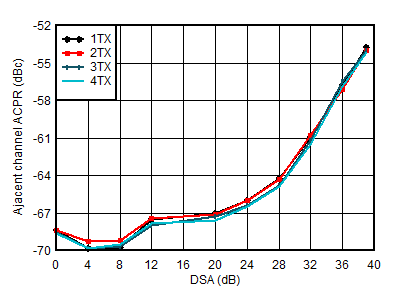
| Matching at 0.8 GHz, single carrier 20-MHz BW TM1.1 LTE |
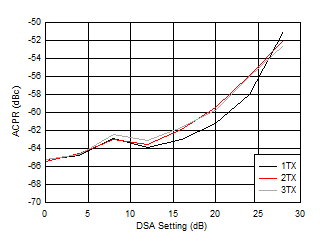
| Matching at 0.8 GHz, single carrier 100-MHz BW TM1.1 NR |
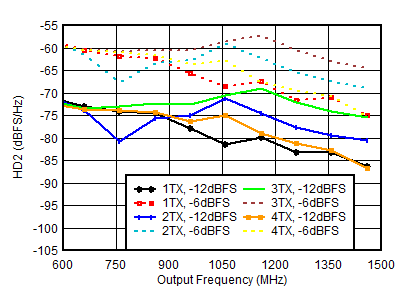
| Matching at 0.8 GHz, fDAC = 5898.24GSPS, straight mode |
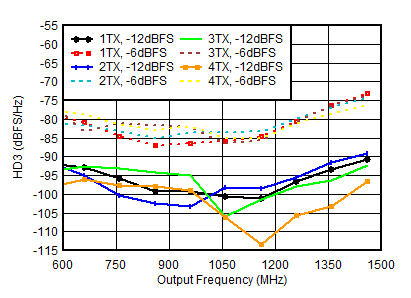
| Matching at 0.8 GHz, fDAC = 5898.24MSPS, straight mode, normalized to output power at harmonic frequency |
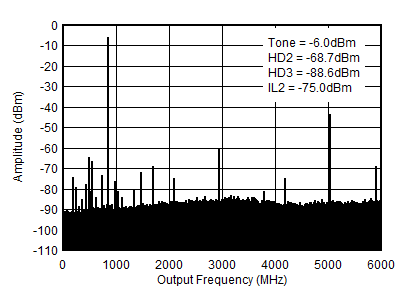
| fDAC = 5898.24MSPS, interleave mode, 0.8 GHz matching, includes PCB and cable losses. ILn = fS/n ± fOUT. |
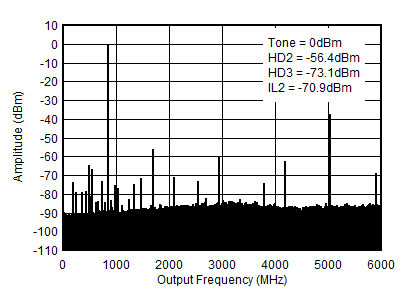
| fDAC = 5898.24MSPS, interleave mode, 0.8 GHz matching, includes PCB and cable losses. ILn = fS/n ± fOUT. |
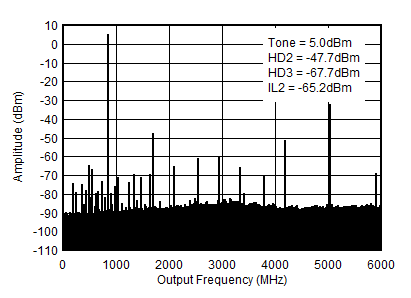
| fDAC = 5898.24MSPS, interleave mode, 0.8 GHz matching, includes PCB and cable losses. ILn = fS/n ± fOUT. |
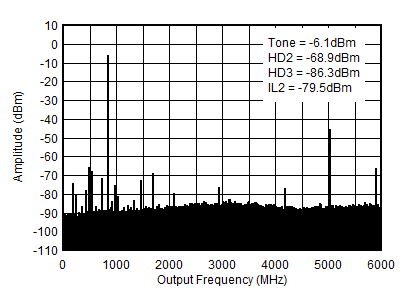
| fDAC = 5898.24MSPS, straight mode, 0.8 GHz matching, includes PCB and cable losses. ILn = fS/n ± fOUT and is due to mixing with digital clocks. |
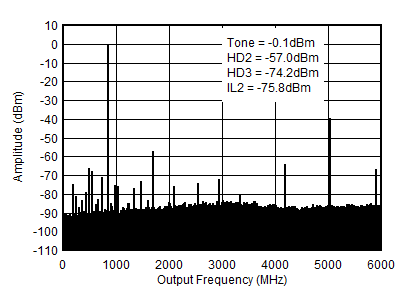
| fDAC = 5898.24MSPS, straight mode, 0.8 GHz matching, includes PCB and cable losses. ILn = fS/n ± fOUT and is due to mixing with digital clocks. |
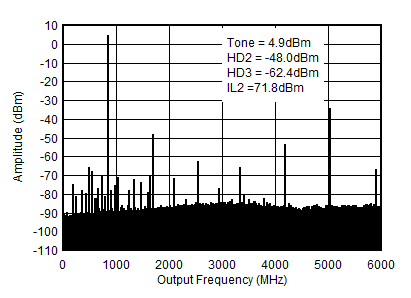
| fDAC = 5898.24MSPS, straight mode, 0.8 GHz matching, includes PCB and cable losses. ILn = fS/n ± fOUT and is due to mixing with digital clocks. |
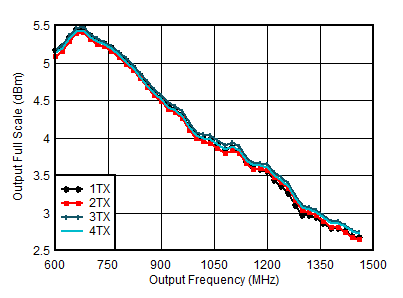
| Including PCB and cable losses, Aout = -0.5dFBS, DSA = 0, 0.8 GHzmatching |
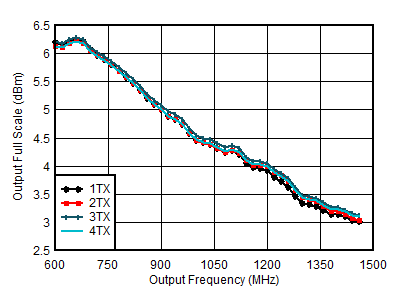
| Including PCB and cable losses, Aout = -0.5dFBS, DSA = 0, 0.8 GHz matching |
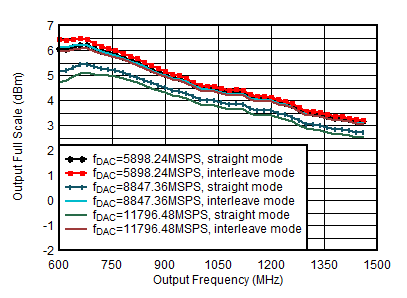
| including PCB and cable losses, Aout = -0.5dFBS, DSA = 0, 0.8 GHz matching |
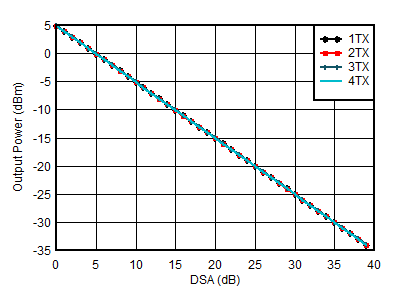
| fDAC = 11796.48 MSPS, interleave mode, Aout = -0.5dFBS, matching 0.8 GHz |
|
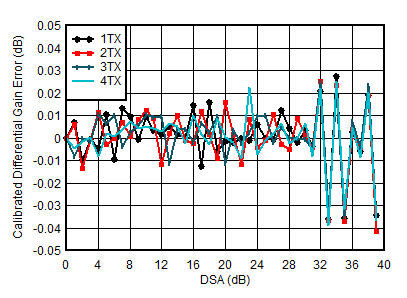
| fDAC=5898.24MSPS, interleave mode, matching at 0.8 GHz |
| Differential Gain Error = POUT(DSA Setting – 1) – POUT(DSA Setting) + 1 |
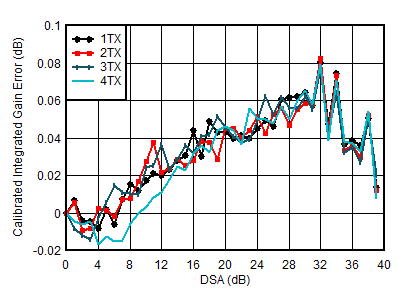
| fDAC=5898.24MSPS, interleave mode, matching at 0.8 GHz |
| Integrated Gain Error = POUT(DSA Setting ) – POUT(DSA Setting = 0) + DSA Setting |
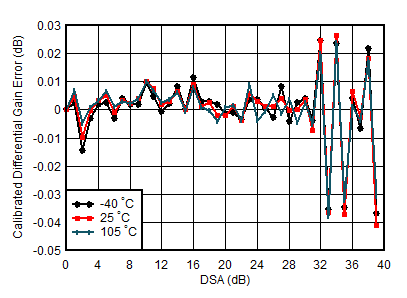
| fDAC = 5898.24MSPS, interleave mode, matching at 0.8 GHz |
| Differential Gain Error = POUT(DSA Setting – 1) – POUT(DSA Setting) + 1 |
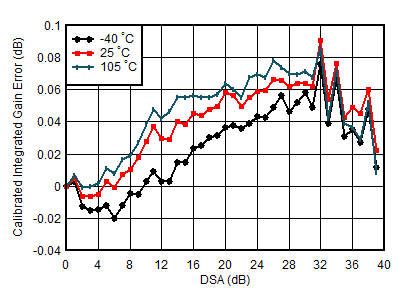
| fDAC = 5898.24MSPS, interleave mode, matching at 0.8 GHz |
| Integrated Gain Error = POUT(DSA Setting ) – POUT(DSA Setting = 0) + DSA Setting |
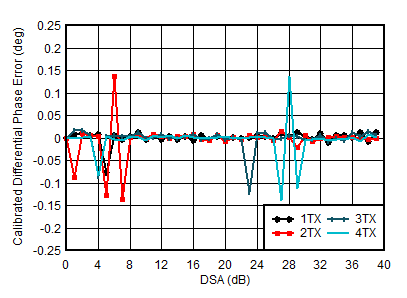
| fDAC = 5898.24MSPS, interleave mode, matching at 0.8 GHz |
| Differential Phase Error = PhaseOUT(DSA Setting – 1) – PhaseOUT(DSA Setting) |
| Phase DNL spike may occur at any DSA setting. |
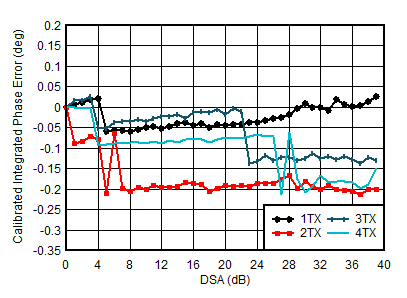
| fDAC = 5898.24MSPS, interleave mode, matching at 0.8 GHz |
| Integrated Phase Error = PhaseOUT(DSA Setting) – PhaseOUT(DSA Setting = 0) |
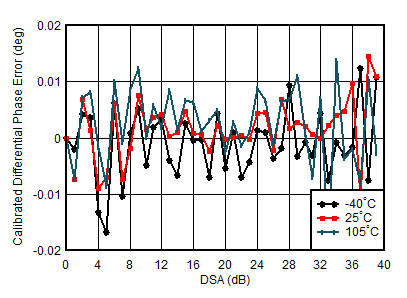
| fDAC = 5898.24MSPS, interleave mode, matching at 0.8 GHz, channel with the median variation over DSA setting at 25°C |
| Differential Phase Error = PhaseOUT(DSA Setting – 1) – PhaseOUT(DSA Setting) + 1 |
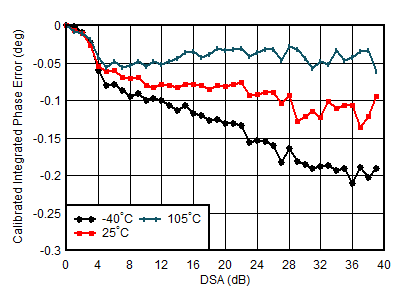
| fDAC = 5898.24MSPS, interleave mode, matching at 0.8 GHz |
| Integrated Phase Error = PhaseOUT(DSA Setting) – PhaseOUT(DSA Setting = 0) |
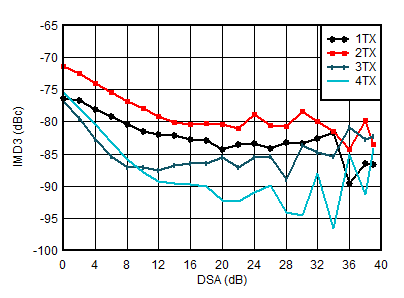
| fDAC = 11796.48MSPS, interleave mode, fCENTER = 0.85 GHz, matching at 0.8 GHz, –13 dBFS each tone |
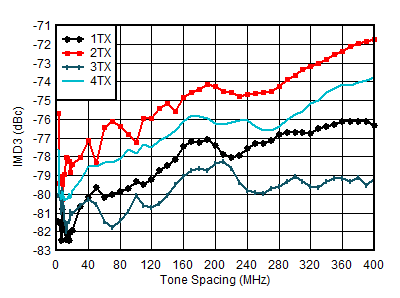
| fDAC = 8847.36MSPS, straight mode, fCENTER = 0.85 GHz, matching at 0.8 GHz, –13 dBFS each tone |
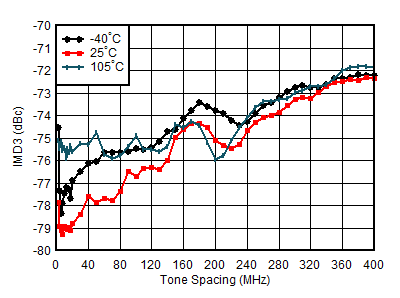
| fDAC = 5898.24MSPS, straight mode, fCENTER =0.85 GHz, matching at 0.8 GHz, –13 dBFS each tone, worst channel |
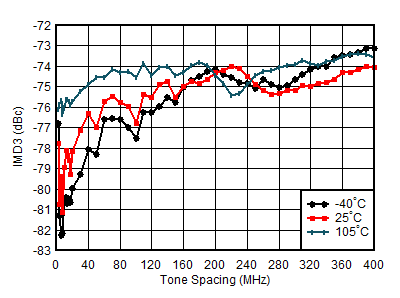
| fDAC = 11796.48MSPS, straight mode, fCENTER =0.85 GHz, matching at 0.8 GHz, –13 dBFS each tone, worst channel |
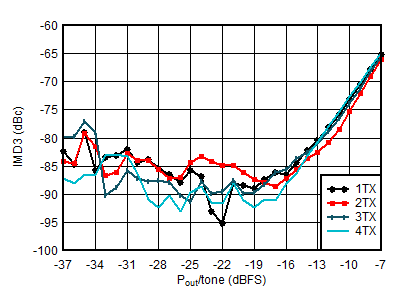
| fDAC = 8847.36MSPS, straight mode, fCENTER = 0.85 GHz, fSPACING = 20 MHz, matching at 0.8 GHz |
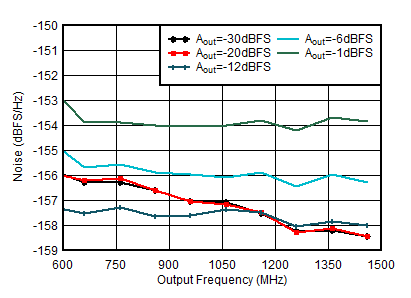
| Matching at 0.8 GHz, Single tone, fDAC = 11.79648GSPS, interleave mode, 40-MHz offset, DSA = 0dB |
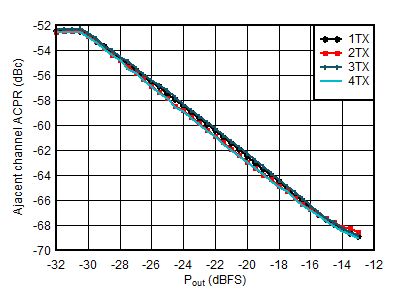
| Matching at 0.8 GHz, single carrier 20-MHz BW TM1.1 LTE |
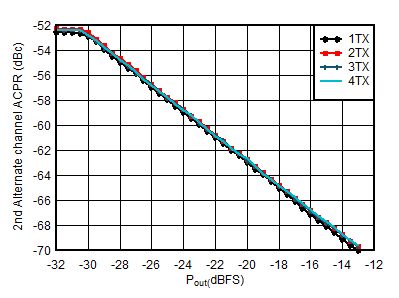
| Matching at 0.8 GHz, single carrier 20-MHz BW TM1.1 LTE |
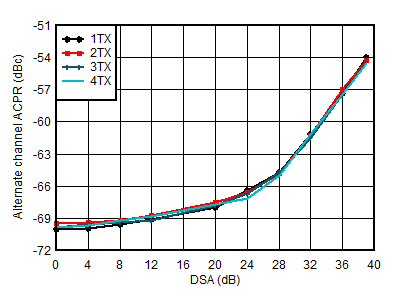
| Matching at 0.8 GHz, single carrier 20-MHz BW TM1.1 LTE |
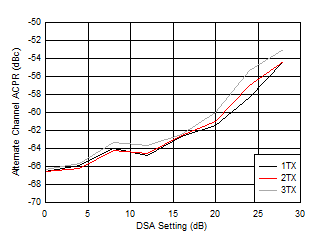
| Matching at 0.8 GHz, single carrier 100-MHz BW TM1.1 NR |
|
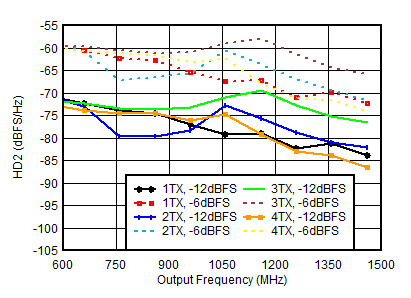
| Matching at 0.8 GHz, fDAC = 8847.36GSPS, straight mode |
|
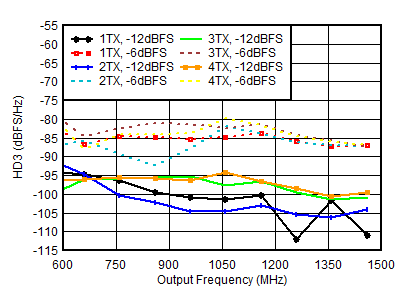
| Matching at 0.8 GHz, fDAC = 8847.36MSPS, straight mode, normalized to output power at harmonic frequency |
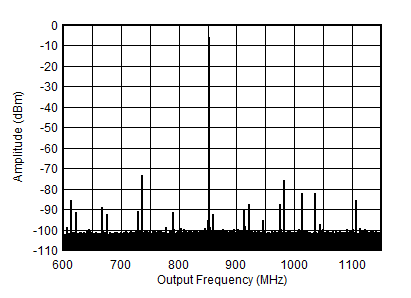
| fDAC = 5898.24MSPS, interleave mode, 0.8 GHz matching, includes PCB and cable losses |
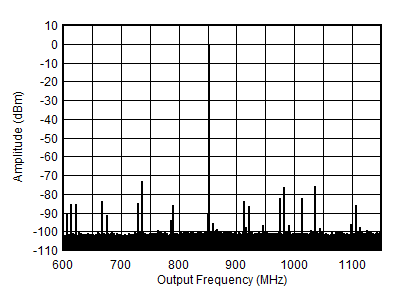
| fDAC = 5898.24MSPS, interleave mode, 0.8 GHz matching, includes PCB and cable losses |
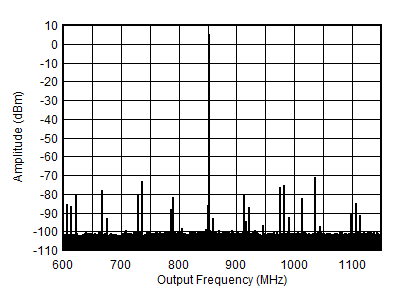
| fDAC = 5898.24MSPS, interleave mode, 0.8 GHz matching, includes PCB and cable losses |
|
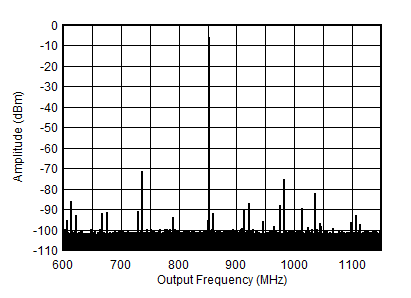
| fDAC = 5898.24MSPS, straight mode, 0.8 GHz matching, includes PCB and cable losses |
|
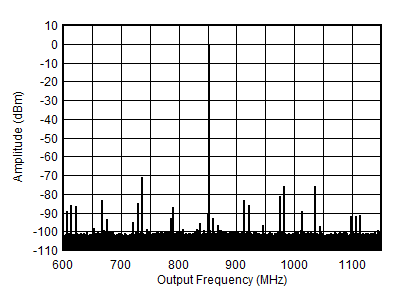
| fDAC = 5898.24MSPS, straight mode, 0.8 GHz matching, includes PCB and cable losses |
|
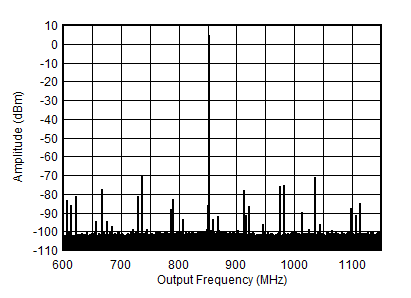
| fDAC = 5898.24MSPS, straight mode, 0.8 GHz matching, includes PCB and cable losses |



























































